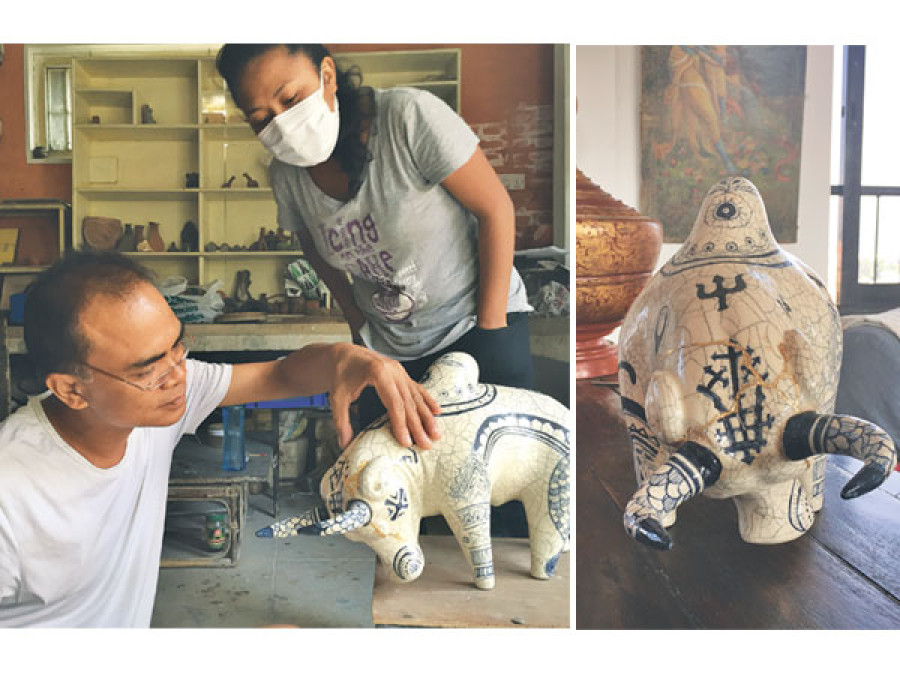Entertainment
Putting Things Back Together: The Art of Kintsugi
Many things were broken or damaged during the earthquake: homes, infrastructure, schools, people’s fragile minds, and among the tangible debris that we can now start to speak about
Sophia Pande
It is not easy to think about material damage, especially when everyone’s thoughts were automatically pulling towards the more pressing misery of people who had lost so much. Personally speaking, unable to process or even look at all the broken objects that meant something to me, I gathered everything in a pile in a corner and left them be until I could come back to them with any kind of clarity or mental soundness. Looking at them, I knew, in the hours and days after the first quake, would have been like looking into the abyss.
Yet throughout the weeks that followed the first and then the second quake, side by side with the rising count of destruction and lives lost, there was also an inevitable accounting of paintings that had been damaged, the museums that had been irreparably cracked, the temples that had collapsed, taking with them all their sacred contents and religious as well as culturally sacrosanct objects that were centuries old and in some cases, irreplaceable.
A visit to Bal Mandir in Naxal to monitor whether the children had been safely relocated (they have), was accompanied by another horrific revelation: the old palace structure that housed the government-run orphanage is also the site of the Nepal Academy of Fine Arts (NAFA) galleries that have, in addition to exhibition spaces, a huge archive of art works by some of Nepal’s most renowned artists. The children had been saved—thankfully it had been a Saturday morning— and they were all in an open space just outside of the building at a programme, but the spine-chilling damage to the structure of the building ensured that the dedicated art students who helped rescue the artworks from the archives did so at great personal risk, willing to put their lives on the line to save inanimate objects.
Seeing such ubiquitous breakage, I was reminded of a time, years ago, when I had been told by a fellow art historian of the incredible Japanese technique, dating possibly to the late 15th Century, whereby broken pottery was lovingly pieced back together, joined by a special kind of lacquer that was dusted with gold; the cracks were therefore made visible by the luminosity of the material.
The process, conceived to celebrate the very cracks, is known as ‘kintsugi’ or ‘kintsukuroi’, and can be viewed via a few philosophical lenses: the ‘wabi-sabi’ philosophy that embraces that which has been broken and is therefore imperfect, or one of the founding principles of ‘mushin’—a way of life that has to do with living without attachments to physical objects and accepting that everything changes.
When I could finally go back to my pile of broken objects, a damaged ceramic bull (one of a total of 20), made by Gopal Das Shrestha earlier this year before the earthquake, reminded me yet again of the kintsugi technique—the bull in my house had lost a paw, a clean break as it fell off a low table, even though I had placed him purposefully close to the floor in the event of the great earthquake that I knew would come in my lifetime.
Another of Gopal’s bulls, bought with much reverence by a friend, had not fared as well. It had crashed off a high surface with its body intact but the head broken into over two dozen pieces. We discussed making an emergency phone call to Gopal, and when the time was right he came to assess the damage. Much to my delight he immediately put forward the idea of repairing the bulls via the kintsugi method—perhaps not such a huge surprise in retrospect when one remembers that Gopal himself was initially trained by a Japanese master ceramist in the tradition of Raku, an extremely complex kind of glazing with which the bulls are finished.
Over the course of two Saturdays, we met at Gopal’s workshop to start the laborious process of piecing together the bulls. First they were joined together by a kind of artist’s cement, a task that could only be entrusted to the maker of such a delicate object. While my bull was made whole in a few minutes, the other one took the better part of that day. When Gopal was done, the bull at a first glance looked like it had never been broken.
Yet all of us wanted to continue the process of highlighting the cracks, not to romanticise the damage the earthquake had caused in any way, but to have the work serve as a glimmering symbol of the destruction the quake had wrought—for the sake of posterity. When the bulls were finally done, over the course of yet another painstaking Saturday afternoon, they were, at least to my mind, even more special than before, precisely because they had been broken, and then so lovingly restored by a man who was willing to spend his only free days remaking something he had already spent so much time and effort on.
I am aware that I could extrapolate the process by which these bulls were repaired into a rather obvious metaphor for rebuilding Nepal; but we cannot gild collapsed houses and damaged schools. However, as we do start the process of reconstruction, we can take from the philosophies that gave birth to kintsugi by accepting that we have been through something life-changing, and appreciating that now we must move on and
repair all that is broken, but in the spirit that even after shattering, given time and patience, things can have another life.




 8.12°C Kathmandu
8.12°C Kathmandu










